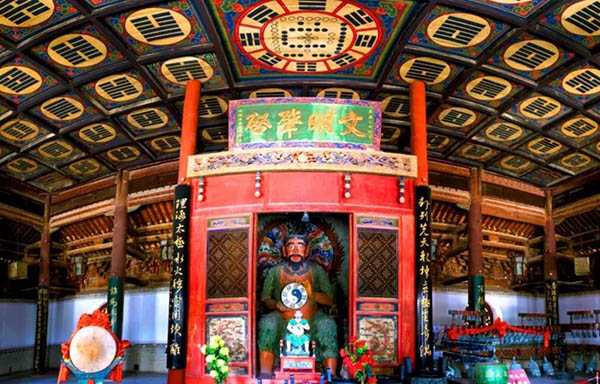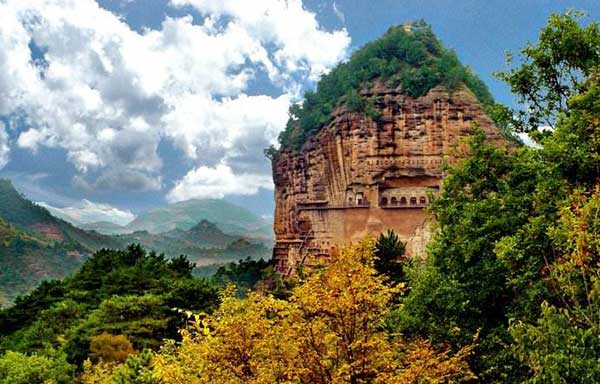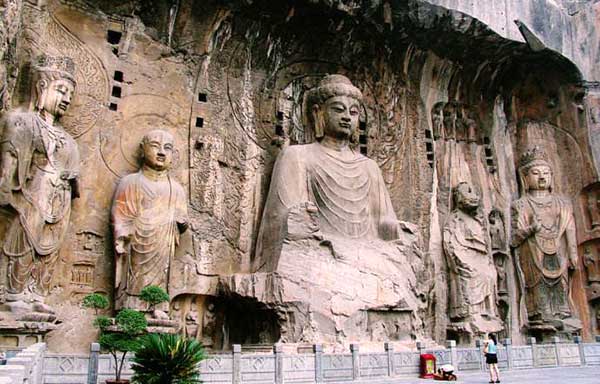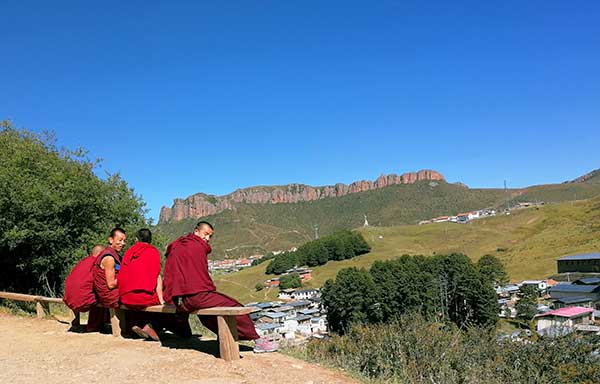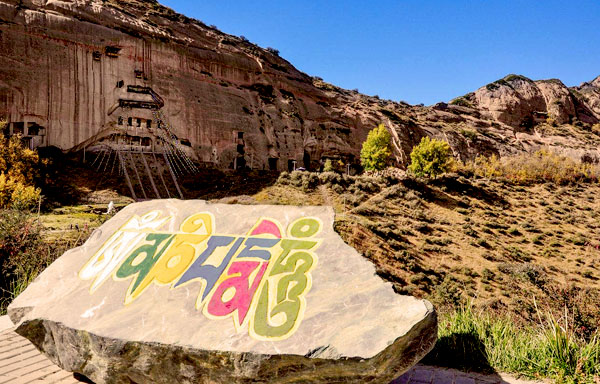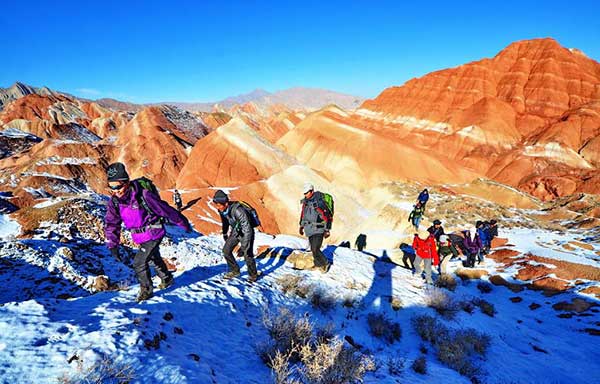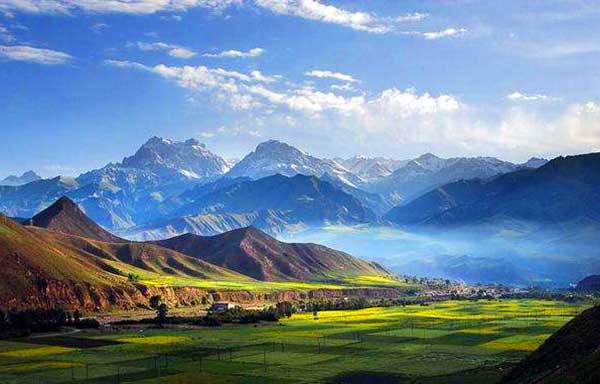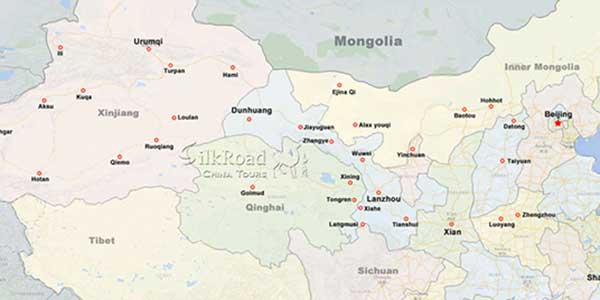 aiji Mountain is 150 meters tall, and it was named for its shape -- like that of a pile of wheat. According to historical records, the Maiji Grottoes were excavated during the Hou Qin Dynasty of the Sixteen Kingdom Period. The Maiji Mountain Grottoes have a long history. Excavation and rock carving continued for more than a thousand years. During the Beizhou Dynasty, Liyunxin built the Seven-Buddha Pavilion in memory of his deceased father. Emperor Wen Di of the Sui Dynasty ordered the construction of a Buddhist nun site. The present dagoba on the top of the mountain was rebuilt in the Qing Dynasty. A lot of the original temples have been destroyed, but a lot remain. There are very old frescoes dating from before the Sui Dynasty.
aiji Mountain is 150 meters tall, and it was named for its shape -- like that of a pile of wheat. According to historical records, the Maiji Grottoes were excavated during the Hou Qin Dynasty of the Sixteen Kingdom Period. The Maiji Mountain Grottoes have a long history. Excavation and rock carving continued for more than a thousand years. During the Beizhou Dynasty, Liyunxin built the Seven-Buddha Pavilion in memory of his deceased father. Emperor Wen Di of the Sui Dynasty ordered the construction of a Buddhist nun site. The present dagoba on the top of the mountain was rebuilt in the Qing Dynasty. A lot of the original temples have been destroyed, but a lot remain. There are very old frescoes dating from before the Sui Dynasty.
In the area are preserved 194 grottoes of dynasties such as the Beiwei, Xiwei, Beizhou, Sui, and Tang, the Five Dynasties, Song, Yuan, Ming and Qing. There are 7000 clay sculptures and carved stone statues. This grotto group, unlike the column-centered caves in the famous Mogao Grottoes, was built fully according to ancient Chinese tradition. Many fine statues, carved before the Sui Dynasty, are much more valuable than the statues in the Mogao Grottoes that were modified afterwards during several dynasties.
The artistic style in these grottoes show the influence of Central Asian cultures. The Maijishan Grottoes display the features of the culture of the Central Plains because its geographical position is near the Central Plains. The Yungang Grottoes, Sichuan Dazu Rock Carvings, Huangze Temple Caves and the Maijishan Grottoes impacted each other in style.
In the Maijishan Grottoes, the tallest statue is 16 meters tall and the smallest is only 10 cm tall. The statue in Grotto No. 44 is called "The Venus of the East."On the frocks of the statues in Grotto No. 78 and Grotto No. 128, patterns were curved with vivid detail. In Seven-Buddha Pavilion that is over 70 meters in height, the statue is of delicate beauty, and on the top of the aisle the frescoes are exquisite. At the western end of the aisle, are carved carriages and pedestrians which are heading different directions which can be viewed from different angles. It can be rated as the masterpiece of Chinese fresco composition. See ancient grottoes in China.
The Maijishan Grottoes are part of the Maijishan Mountain scenic reserve area with forests and a large variety of plants and animals. It is a beautiful scenic spot in the area and has interesting geology. The mountain peak is about 1,700 meters above sea level.
Gallery
Attractions in the area
Related Tours
General Information
Alias: No
Loc: 46 km from Tianshui
Entrance: 85 RMB
Open Time: 8:00~17:00
Relevant blogs
-
How did the name of Tianshui in Gansu come about?
The name Tianshui is very pleasant to the ear, and it reminds one of that exquisitely beautiful verse, "After getting drunk, one doesn't know if the sky is in
-
The 8th Silk Road Hotel Festival was successfully held i
On December 27th, the "8th Silk Road Hotel Festival" grandly opened at the Yujing International Hotel in Zhangye. This hotel festival gathered industry experts,
-
The Karez Irrigation System in Turpan has been selected
On September 3rd, at the 75th Executive Council Meeting of the International Commission on Irrigation and Drainage held in Sydney, Australia, the 2024 (11th bat
-
What is the connection between "dragons" and "snakes
In traditional Chinese culture, the snake has a dual identity of auspiciousness and danger. Ancient people believed that the snake not only possesses divine cha
-
Endangered Przewalski's Horses Spotted at Dunhuang Yume
<p>In early February, a group of special "visitors"—the Przewalski's horses—appeared at the Dunhuang Yumen Pass scenic area in Gansu Province, a U
-
The Fourth Dunhuang Cultural Tourism Supplier Conference
On the morning of February 18th, the Fourth Dunhuang Cultural Tourism Supplier Conference in Northwest China commenced at the Dunhuang International Convention






